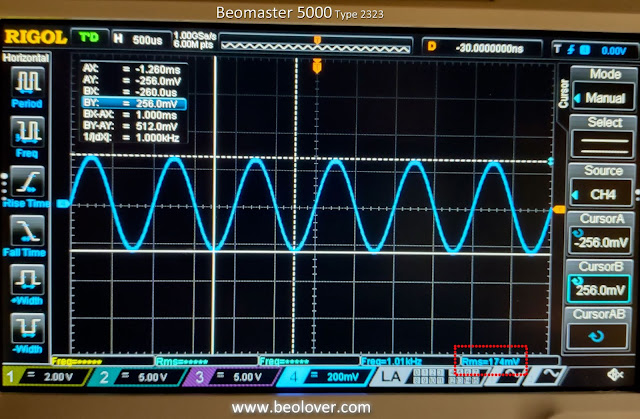The Beomaster 5000 (Type 2323) service manual has some adjustment procedures to calibrate the volume level for the left and right channel stereo outputs and for the bass and treble levels.
Unlike older style amplifiers the Beomaster 5000 has pushbutton up and down buttons for volume, bass and treble.
The calibration of those volume controls uses a 175mVrms sine wave test signal input to the Beomaster 5000 Tape 1 source.
For Left and Right channel volume calibration the test signal uses a frequency of 1000 Hz.
For the Bass level calibration the test signal uses a frequency of 40 Hz and for the Treble level calibration a frequency of 12,500 Hz is used.
The adjustments are made on the PCB 3 : Preamplifier board.
There are trimmer resistors for the Left and Right volume levels and for the Bass and Treble levels.
The execution of the calibration procedure is to set the Beomaster 5000 tone control setting to Neutral (no tone controls). The volume level for the Beomaster is set to its maximum level (6.0) and the input source selection is set to Tape 1. The test points (TP100 and TP200) should measure 4.2 Vrms when the levels are adjusted properly.
Here is the test setup...
The volume level adjustments and measurements are made using TP200 (Left Channel) and TP100 (Right Channel).
Here is the measurement using the 175mVrms, 1KHz sine wave test input on Tape 1 and measured at TP200. The desired output is 4.2 Vrms.
I made the same adjustment and measurement on TP100 for the Right channel.
For the Bass level adjustment the Tape 1 input test signal is set to 40 Hz (and 175 mVrms).
The output is measured at TP200 only for this adjustment. Again, the target output is 4.2 Vrms.
The next tests were to use my QuantAsylum QA401 Audio Analyzer to do a quick check of the amplifier audio outputs for the left and right channels.
As I normally do I run a test for Total Harmonic Distortion (THD) using a sine wave test input of 1KHz and the output amplifier at its rated output across a dummy speaker load of 8 ohms.
The input source I selected for this test is the Beomaster 5000 AUX input and I decided to use an input amplitude of 0.316 Vrms (-10dBV on the audio analyzer).
I want to check the THD for the left and right channels with the output amplifier running at 55 Watts.
Note: Because of the way the volume level steps in the Beomaster 5000 I had to adjust my input voltage up a bit to 0.332 Vrms (-9.5dBV on the audio analyzer) in order to hit my target output of 55 Watts.
The Beomaster 5000 measured great on both tests.
The THD levels were well below the value stated in the service manual of <0.09%.
The Frequency Response was nice and flat from 20 Hz to 20,000 Hz not varying by more than ±1.5 dB.
The actual music sound from the Beomaster 5000 is the important thing of course. It is also the fun part of an audio component restoration.
I have now listened to this amplifier for over forty eight hours and it plays beautifully again.
I still have to finish exercising all of the input source options before I am ready to send this unit back home.










No comments:
Post a Comment
Comments and suggestions are welcome!